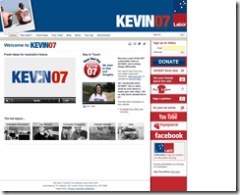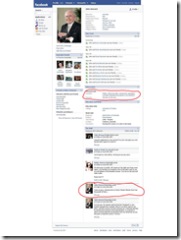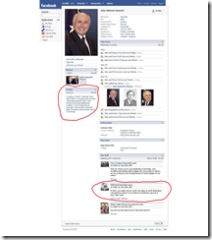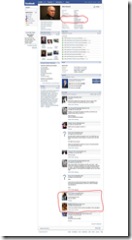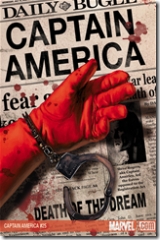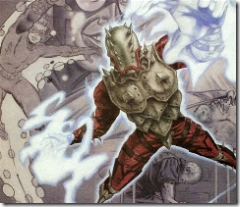Home » politics (Page 15)
Category Archives: politics
Kevin 07! (Or: Team Rudd gets its Web2.0 on!)

So, Kevin07 is here! Australian Labor leader Kevin Rudd has gotten all web2.0 and has a new portal website which integrates nicely with Labor and Rudd’s re-vamped MySpace page, YouTube and Facebook. As I’ve discussed in the past month, Labor has already shown far more success in using MySpace and Facebook than the Liberal party. Liberal leader and current PM John Howard has tried to use YouTube, but each video clip led to the deleting of comments and each video also seems to have less and less viewers.
Kevin07 was launched today, so for historical archival purposes, here is a full screenshot from day one:
The layout is fairly straight-forward and is clearly based on a the design of both the Hillary08 (screenshot) and Obama08 (screenshot) campaigns for the 2008 US Presidential election. There is a little danger in Australia in pushing the individual (Kevin) over the party (Labor) since Australians are still less comfortable with celebrity politics (hence, among other things, no Australia President) but I’ve got to say I think the Labor media advisors have done a very decent job on this portal. In an article in PerthNow, Rudd’s team certainly seem to be making the right noises about how social software would work during the election campaign:
“Kevin07 will encourage supporters to interact with one another, participate in blogs and stay in touch with what is happening on the campaign trail,” Labor’s campaign director Tim Gartrell said.
On the negative side, ABC News has a story about some very strongly worded responses from Liberal Party faithful:
But Assistant Treasurer Peter Dutton says voters will eventually see the light, and has labelled Mr Rudd’s approach as a “load of crap”.
“People at the moment are looking at Kevin Rudd like they’re looking at a promo for Big Brother,” he said.
“I mean it’s exciting, it’s fresh and when the big night comes, and people actually have a closer look and they look at the detail and they get a better understanding about what the show is about, they actually realise that the show is a load of crap.”
“The thing I say to Australians is please, don’t just look at the media tart, look at the policy detail.”
However, what Peter Dutton fails to understand, is that a generation who started watching Big Brother when they were 13 are old enough to vote this year. More to the point, dismissing the web, which is a central social space for those in the late teens and twenties, is clearly alienating the majority of a key demographic group. On more stable ground, The Age has tried to take Team Rudd to task for not registering all the possible Kevin07 variant domains (.net, .org etc) but if that’s the only issues the mainstream media can find, then I’d have to say Kevin07 is a winner in terms of design and its connectivity with voters.
The US Presidential Race ’08 is now a pillow-fight between bikini-clad crush girls!
As Chuck and a quite a few others have pointed out, Barely Political have released another viral video, this time featuring an MTV style showdown between the singing, dancing political spokesmodel* Obama Girl and her political nemesis, Giuliani Girl:
I rather like Chuck’s description of this clip as a “a singing and dancing competition on the streets of Brooklyn that suggests a spiced up version of West Side Story, with a little politics thrown in.” As with the Obama Girl and Hott4Hill clips discussed earlier, the question as to whether these clips actually have any meaningful place in promoting political awareness is an important one. The lyrics certainly presume some knowledge of politics and of the candidates, but I suspect the demographic most likely to be watching the videos in YouTube are probably not of voting age.
As Craig Rubens from NewTeeVee asks:
Is this the “Happy Birthday Mr. President” of the YouTube era? The ladies of Barely Political owe quite a bit to the imitable Marilyn Monroe. Or is this more the Jib Jab of the 2008 election, whose This Land traveled in very much the same media circles back on ‘04?
I like the comparison with Jib Jab, as it certainly reminds us that US politics has already had its first election (’04) with viral video input, and the Crush Girl vids have some sort of history. That said, I also worry with Rubens that for all the cynicism about politics in the US, given such a narrow ranges of choices at the end of the day, these clips really could make a difference in an apathetic voter’s mind:
So, will Barely Political work its way up to political punditry levels of Stewart/Colbert? Likely not, but it’s broken new ground with the powers of viral videos, coming out with multiple iterations of a successful formula. I’d like to think that my vote won’t be influenced by Hooters girls chanting political candidates names, but like I said before, I am a member of an easily swayed demographic. So, while maybe not the most cerebral of political commentaries, Obama girl very well might be the most primal.
In a clearer light, it’s great to see Taryn Southern (who didn’t just perform, but also wrote the Hott4Hill clip) bemused by the fact that many commentators are missing the that fact that her clip, at least, is definitely satirical:
I’m still surprised at the number of people who don’t realize the video is a parody. Between Hillary’s face in Mt. Rushmore and my bikini body superimposed on George Washington crossing the Delaware, how could it get anymore silly?
Meanwhile, on the home front, the Oz in 30 Seconds citizen-produced political video campaign in Australia (run by GetUp) has entered the voting phase. Nothing as racy as the US clips, but some really impressive political commentary to be seen here!
* I’ve loved the term spokesmodel ever since hearing it for the first time in the wonderful film LA Story. I’m so pleased to finally have an appropriate context in which to use it!
Australian Politicians on MySpace this week…
The Australian ran a couple of stories today about Australian politics finding another outlet in MySpace’s ‘Impact’ website (the Australian version).
In Nicola Berkovic’s ‘Kevin has more ‘friends’ than John’, she points out that Labor is doing much better in MySpace than the Liberal Party. As Berkovic notes:
Yesterday afternoon, the Opposition Leader had more than 800 friends, while the Prime Minister had a measly seven. And most of them were fellow Liberal MPs. However, it is also a risky strategy for politicians, who are used to their minders having some degree of control over their image and political message. […]
Many of Mr Rudd’s MySpace friends are preoccupied with the issues that interest many young people: drinking, smoking and sex. […] However, Mr Rudd said, provided that people did not post defamatory or profane comments on his site, he was relaxed about losing control over his image on the internet. “It’s just life in the fast lane,” the Opposition Leader said.
I’d say Kevin Rudd’s attitude is probably a sensible one (and its not like any of the politician on MySpace are actually likely to see their own profiles). That said, in ‘MPs cast cyber net in hunt for votes’, Cath Hart points out that:
The emergence of e-campaigning in Australia is set to mirror the trend in the US, where presidential candidates have embraced the internet – for fundraising and profile building – as the 2008 race moves into full swing. Speaking at the launch of MySpace’s new political channel, Impact, yesterday, Mr Rudd described the site as the “public meeting place for the 21st century”, where his goal is “to get 50per cent … plus one more friend than Mr Howard”. “It’s a good shot in the arm for Australian democracy to keep it alive into the next century.” […]
But media and internet experts have warned Mr Rudd and the swag of other “e-MPs”, or online politicians, that social networking sites can be a double-edged sword. Internet networking expert Joanne Jacobs said the sites offered access to the “student market” of people under 24. “The trouble with these networking sites is that … they open the writer up to criticism. It also means you don’t have a moderating path to vet out unpopular comment,” she said.
Following Joanne Jacobs’ comments, I suspect the real test of Rudd’s take on social networking websites will come when he does something massively unpopular and has to deal with the backlash!
For today, thought, lets look at MySpace friends:
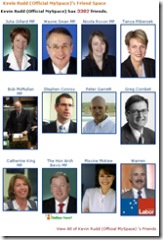 Labor leader Kevin Rudd, has 3382 friends;
Labor leader Kevin Rudd, has 3382 friends;
 Julia Gillard (Deputy Leader for Labor) has 687 friends.
Julia Gillard (Deputy Leader for Labor) has 687 friends.
In the middle, Bob Brown (leader of the Greens) has 173 friends, while Democrat Senator Andrew Bartlett has 163 friends (although, already being Australia’s most web2.0-savvy politician, Bartlett already blogs extensively and has clearly stated that he only has time to treat MySpace as a re-posting space for his blog);
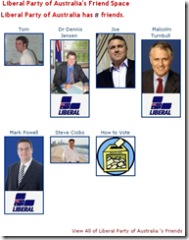 Meanwhile, Australian Prime Minister John Howard only has 8 friends (and Peter Costello, oddly enough, isn’t one of them!). While the generation gap is clearly one factor, I strongly suspect that Howard’s camp simply aren’t checking friend requests (and thus Howard will probably never have more than 8 friends!). This is similar to what Jill mentions about politics in Norway, in that candidates are using online networks like MySpace or YouTube without having teams literate in how these websites actually work. (Another argument for the importance of digital literacies right there!)
Meanwhile, Australian Prime Minister John Howard only has 8 friends (and Peter Costello, oddly enough, isn’t one of them!). While the generation gap is clearly one factor, I strongly suspect that Howard’s camp simply aren’t checking friend requests (and thus Howard will probably never have more than 8 friends!). This is similar to what Jill mentions about politics in Norway, in that candidates are using online networks like MySpace or YouTube without having teams literate in how these websites actually work. (Another argument for the importance of digital literacies right there!)
Incidentally, the popularity of certain politicians doesn’t seem to be rubbing off on the youth arms of either major party: on MySpace the Young Liberals currently have 50 friends while Young Labor isn’t doing much better with 110 friends.
Returning to Australian Politics on Facebook discussed last week, Kevin Rudd is up to 1296 friends, while there still doesn’t appear to be a real John Howard. I’ll leave you to draw your on conclusions on that front!
(All friend counts and screenshots were taken between 3pm and 3.40pm Perth Time on 13 July 2007.)
Facebook and Australian Politics?
Over the past month I’ve suddenly seen Facebook grow from an oddity to something on which the majority of my university-based friends appear. Since I spent some of yesterday pondering the oddities of US politics and digital culture, I thought I’d spend a little of today looking at Australian politics. For those of you not in the know, Australia has what amounts to a two-party political system, divided between Liberal (close to Republican/Tory parties) and Labor (close to the Democrat/UK Labor parties); the Liberal party is led by John Howard, who is our current Prime Minister, while the Labor party, after many years of leadership ambiguity, is led by Kevin Rudd.
Unlike the US (and a lesser extent the UK), mainstream press and politics in Australia really hasn’t embraced either the blogosphere or social networking as a means of promotion or gaining support (and Australian politicians can’t and don’t fund-raise in the explicit way US politicians do). That said, younger voters are clearly looking for some sort of connection with the political sphere, even if its not done through the same rhetoric of civil participation that comes through the US education and advocacy systems. So, that said, is either Australia’s Prime Minster or his Labor rival on Facebook? The answer, initially, appears yes to both, although after some scrutiny, the answer changes to yes for Rudd and no for John Howard – there are, in fact, three Howards, but all are fake.
Of the three Howards, two are obvious fakes, while one is more subtle, but still not authentic. Since this is a fun moment to think about digital literacy, I’ve taken screenshots of the three Howard profiles and circled in red the most obvious indicators that these aren’t authentic pages.
and John Howard #3 …
In contrast, Kevin Rudd’s Facebook page is rather dull, but clearly authentic. (I’ve just made a friend request, so if there’s anything exciting in friends-only land, I’ll write a little more.) It is worth noting that comments which cast John Howard as a sexual or ‘hot’ figure are unambiguously meant to be satirical, in contrast to the clips from the US mentioned yesterday which, while playful, aren’t necessarily ironic (although they might be, especially Hott4Hill).
Putting the Sex (back) into American Politics?
The process by which different US Democrats and Republicans vie for the right to be their party’s candidate for presidency has always fascinated me (admittedly, from afar, safe in the knowledge I don’t need to vote for any of these people). The race for 2004 bought out some impressive efforts in participatory culture (remember Jib Jab’s ‘This Land’?), and this years’ Hillary 1984 video promised more in the race for 2008. While the creativity is definitely out there, one trend which has been a little unexpected is the “I’ve got a crush on…” videos attached to the Democrat candidates.
First there was the self-styled ‘Obama Girl’ with her “I’ve Got a Crush on Obama” video:
The clip and the Obama Girl herself have gained a fair amount of attention in US media, most of which is linked to from Obama Girl’s website. The girl in the clip – Amber Lee Ettinger – didn’t create the concept (or sing the song; she’s lip-synching) but has become one of the key faces in Obama’s campaign. The story behind Obama Girl is found at the Barely Political website. Now, along similar lines but a little more disturbingly, Chuck Tryon has drawn my attention to the “Hott4Hill featuring Taryn Southern” clip, which runs a fine line between representing Hillary Clinton as a politician or a sexual icon(!):
And, of course, there’s a Hott4Hill blog to emphasise Taryn Southern’s efforts.While I’m still thinking about how all of this works (and wonder if these clips have the potential to damage campaigns as much as make them appealing for younger proto-voters) you might want to have a read of ‘The Power and Playfulness of Parody: Obama, Hip Hop and Misunderstanding’ by Bernie Heidkamp in Pop Politics which gives some context and perspective to the Obama Girl clip.
Indigenous Health is Australia’s Katrina?
While I was away, the health, welfare and abuse issues in some indigenous Australian communites has flared into the political spotlight. The issues aren’t new, but several new reports and issues have focused the debate markedly. That said, I was still quite suprised to hear Australia Prime Minister John Howard comparing these issues to the 2005 Katrina disaster in New Orleans:
“Many Australians, myself included, looked aghast at the failure of the American federal system of government to cope adequately with hurricane Katrina and the human misery and lawlessness that engulfed New Orleans in 2005,” he said in a speech to the Sydney Institute last night. We should have been more humble. We have our Katrina here and now. That it has unfolded more slowly and absent the hand of God should make us humbler still.”
The religious tones here seem particularly unhelpful, and casting this as Australia’s Katrina makes light of the fact that these issues are a systemtic issue which have been around for some time. Sending in the troops (literally) may not be the best approach for communities which still have very real memories of children being forcibly removed from families a generation earlier. That said, change has to happen, and I tend to agree here with Democrat Senator Andrew Bartlett:
There has been a fair degree of cynicism amongst many of the responses to the government’s plan, including from many Indigenous Australians. Given the past history of many grand government announcements which have not been followed up with adequate resourcing or implementation once the headlines have died down, there is every reason for people to be cynical. However, that should not be a reason to try to tear this plan down, it should be a reason to keep the focus on it, to do everything possible to translate all the current waves of rhetorical flourishes into real and lasting positive change.
For your own reading, please …
[X] Read The Northern Terrtitory Inquiry into the Protection of Aboriginal Children from Sexual Abuse and the many, many problems it describes (or, at least, look at the Foreward);
[X] See North Queensland Aboriginal leader Noel Pearson being interviewed last week on the 7.30 report about some of the strategies being implemented (which were recommended in a report he chaired);
[X] But also keep in mind that the timing of this is political since former WA premeir Geoff Gallup called this issue a “national disaster” in 2002 and called for broad-scale national and state-level action in that year (“There needs to be a national approach to this, it’s not just a Western Australian issue”). None happened until a closely run Federal election was looming. (That’s a reason to try and ensure that the energy galvanised here is directed in a sustained way, not a short-burst political way. And, to be honest, even gettings things right here doesn’t make up for all the years that the Howard goverment has done nothing, despite the issues being clear as day.)
Academic Ethics, Privacy and Transparency … all coming soon to YouTube!
Australia’s QUT has been in the grip of a very public controversy recently which dovetails between issues of freedom of speech, academic ethics and the transparency of university processes. The controversy came to light and media attention on 11 April this year when two QUT academics, John Hookham and Gary MacLennan, published an article in The Australian entitled ‘Philistines of relativism at the gates’. In it, Hookham and MacLennan very publicly took issue with the ethics of work being done by PhD candidate, Michael Noonan:
A time comes when you have to say: “Enough!”, when you can no longer put up with the misanthropic and amoral trash produced under the rubric of postmodernist, post-structuralist thought. The last straw, the defining moment, came for us when we attended a recent PhD confirmation at the Queensland University of Technology, where we teach. Candidate Michael Noonan’s thesis title was Laughing at the Disabled: Creating comedy that Confronts, Offends and Entertains. The thesis abstract explained that “Laughing at the Disabled is an exploration of authorship and exploitation in disability comedy, the culmination of which will be the creation and production (for sale) of a six-part comedy series featuring two intellectually disabled personalities. “The show, entitled (Craig and William): Downunder Mystery Tour, will be aimed squarely at the mainstream masses; its aim to confront, offend and entertain.” (Editor’s note: the subjects’ names have been changed to protect their privacy.) Noonan went on to affirm that his thesis was guided by post-structuralist theory, which in our view entails moral relativism. He then showed video clips in which he had set up scenarios placing the intellectually disabled subjects in situations they did not devise and in which they could appear only as inept. Thus, the disabled Craig and William were sent to a pub out west to ask the locals about the mystery of the min-min lights. […]
At the seminar we were told there was a thin line between laughing at and laughing with. There is no such thin line. There is an absolute difference that anyone who has been laughed at knows. We must admit with great reluctance that at the seminar we were alone in our criticism of the project. For us, it was a moment of great shame and a burning testimony to the power of post-structuralist thought to corrupt. It is not our intention here to demolish the work of Noonan, an aspiring young academic and filmmaker. After all, ultimate responsibility for this research rests with the candidate’s supervisory team, which included associate professor Alan McKee, the faculty ethics committee, which apparently gave his project total approval, and the expert panel, which confirmed his candidacy. […]
What we have instead is the reality that cultural studies is in the grip of a powerful movement that we call the radical philistine push. It is this same movement that has seen the collapse of English studies and the consequent production of graduates who have only the scantiest acquaintance with our literary heritage. It is also undermining the moral fabric of the university.
So, what starts with ethical questions about a particular thesis, quickly becomes a much more generic complaint about the corruption of education by poststructuralist and postmodern theory and approaches. I know nothing of the people writing or mentioned in this article, but have to say after reading the piece I wasn’t swayed; my sympathies were more with Michael Noonan than anyone else, because as a PhD candidate I know I would have been almost destroyed by such public denouncing of my work. This, I should add, is not a comment on the quality on the work being or proposed – I know nothing beyond the article above and the surrounding debate, and haven’t seen any of the footage mentioned – but rather a comment on the process and the reasonable expectation that any criticism of a candidate’s work be handled within the university as long as possible. I’m not saying there is never a case for ‘going public’ with dismay about certain research, but from what I’ve read I believe Hookham and MacLennan took that step far too early. More to the point, combining criticism of a specific project with a very generic attack on a particular body of theory and its influence on teaching seems a less than generous way of dealing with the work of a PhD candidate.
The issues raised here also beg serious questions about transparency and universities. There is a lot of talk about the need to transparency of research outcomes since (most) Australian universities are at least partially publicly-funded. I quite agree with that notion. However, I think the idea of the processes of a university being taken public under the rubric of transparency tend to skew what makes it into the public arena. Selectively releasing aspects of a process (such as an ethics review process and confirmation of candidature) around research which clearly relies on careful contextualisation is bound to produce a one-sided picture. Tellingly, when Hookham and MacLennan’s article was republished in Online Opinion, the were comments from a student – using the handle WWSBD – who’d had Noonan (the candidate) as a lecturer, praising his efforts to educate student about people with disability. Moreover, this is the only place I’ve seen Noonan himself comment publicly:
I am at the student at the centre of Hookham and MacLennan’s attacks.
I thank WWSBD for understanding and appreciating my work in its context. I appreciate the words of Anecdote, who understands that a work must be seen and placed in context before it should be attacked. And I am disappointed for bedwin, who has lost all respect for me on the basis of an uninformed and incorrect article.
Much has been assumed about my project, my integrity and my intentions. Very little of it is based on truth. The simple facts are these: the excerpts I showed at my PhD confirmation seminar were presented in the context of exploring and discussing issues of authorship and representation in disability. My project seeks to empower the disabled, to give them a voice through comedy. Each clip was prefaced with my own thoughts about whether or not this had been achieved.
As a sessional staff member at QUT, I can think of nothing more deplorable than attacking a student’s incomplete research in a public forum. Hookham and MacLennan have made no effort to read my PhD confirmation document (it was offered) and they rejected my attempts to meet and discuss their concerns.
To date I have not sought to respond to their attacks in print. But I refuse to be further bullied and vilified before the public, my peers and my students.
However, the story doesn’t end there. Earlier this month The Australian report that Hookham and MacLennan are now facing a disciplinary hearing at QUT for their public comments, with the university arguing that the two unfairly attacked the candidate and his supervisory team. Now, whatever their views, Hookham and MacLennan seem to have a reputation as inspirational teachers themselves, and the news of their censure galvanized some of the QUT student body to defend their actions on the basis of free speech. The student campaign is visible through it’s “Save Our Lecturers” MySpace page. Moreover, over at Martin Hirst’s blog, he has posted ‘Freedom of Speech disabled at QUT’ which points to this documentary which is now available at YouTube:
(Hirst is a friend of Hookham and MacLennan’s, and his post also contains the full text from Hookham and MacLennan’s original article in The Australian, as well as some additional commentary from The Australian and subsequent letters to editor.)
The YouTube documentary clip, by QUT student Adrian Strong, is very compelling; Hookham and MacLennan both come across as intelligent, compassionate teachers and academics who have good cause for concern. My point here is not to judge the debate being documented in this clip – although I imagine it would be extremely compelling for many people. Rather, in the era of participatory culture and digital media, this clip is indicative of a very profound change which can see debates and arguments that once would have remained closed suddenly being open to public viewing and public debate. In such an era, digital literacy is extremely important – the ability to create, edit and share such a clip is a key part of the ability to make a case in the public eye. It’s no surprise that QUT, which has Australia’s most renowned Creative Industries faculty, should be the source of the first such debate in Australia (to my knowledge, at least).
Illustrating my point, I just noticed another posted by the same YouTube user who posted the clip above (and thus, I presume, also be Adrian Strong) which talks in even stronger terms about a perceived campaign of censorship at QUT:
(Again, let me reinforce, I don’t know enough about the other things going on to really judge this debate, but I do know that the perception of censorship certainly doesn’t add to the reputation of any university. However, like the first clip, without any further rebuttal, this clip is likely to be very persuasive to viewers.)
Update: In ‘Dissenting dons out in the cold’, Andrew Fraser reports in The Australian that the saga ended with Hookham and MacLennan both being suspended without pay for 6 months from QUT.
V-Tech Massacre: Tasteless Videogame based on the Virginia Tech Massacre
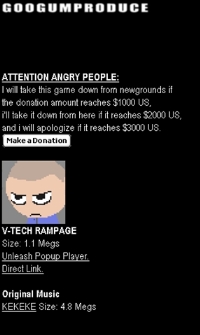 A 21-year old Sydney man, Ryan Lambourn, has sparked outrage by creating a game based on the Virginia Tech Massacre. The game, called V-Tech Rampage, is far from technically impressive, but has nevertheless understandably upset quite a few people. One of the real difficulties is that while there have been a number of important political games and simulations which have tried to ‘speak’ about political issues (from September 12 to Donkey John to World Without Oil) this game – if it does have a point – really doesn’t make that clear. Over at Joystiq, the creator of the game based on the Columbine Massacre is quoted, citing his disappointment with the V-Tech game:
A 21-year old Sydney man, Ryan Lambourn, has sparked outrage by creating a game based on the Virginia Tech Massacre. The game, called V-Tech Rampage, is far from technically impressive, but has nevertheless understandably upset quite a few people. One of the real difficulties is that while there have been a number of important political games and simulations which have tried to ‘speak’ about political issues (from September 12 to Donkey John to World Without Oil) this game – if it does have a point – really doesn’t make that clear. Over at Joystiq, the creator of the game based on the Columbine Massacre is quoted, citing his disappointment with the V-Tech game:
Danny Ledonne, creator of Super Columbine Massacre RPG, writes on Lambourn’s site, “It would appear to me that Ryan has no intention of doing much other than making money and gaining immediate recognition after the Virginia Tech shooting. Inevitably, comparisons between SCMRPG and VTech Rampage are being made right now. Some bloggers despise both games equally whereas others recognize a level of commentary that SCMRPG attempted which was not evident in VTR. For myself I wish to point out that SCMRPG was never a for-profit endeavor and thus I never posted statements like that which is on the VTR game’s homepage”
Adding fuel to the Lambourn posted a notice say he would only remove the game if he received $2000 in donations. This sparked even more vitriolic comments on the game, but in those comments Lambourn defends the donations statement, say it was a further aspect of satire:
PiGPEN – May 15th 2007
Danny, the donation thing is there as a joke against all the people commanding me to take my game down. I didnt think anyone would donate money to it and so far my paypal account has proven me right (BUT I COULD USE SOME FUCKING MONEY THANKS!).
And i’d appreciate if you didnt use the name “Ryan”. That name is reserved for my close friends and family… i cant help the people that gleaned personal information from my website but i would hope you would have the courtesy to not disrespect me in such a manner on my own website…Danny.
Of course, the irony of courting controversy and then being surprised when it results in negative public sentiment (and the post of Lambourn’s full name, address and phone number in numerous locations online) is pretty thick. On the web, even thought two wrongs don’t make a right, they’re never far from each other!
See The Age for more details.
Update (17 May, 2:25pm): The ‘official’ version of the game hosted by Lambourn (and this whole website) have been taken down. (That said, given the nature of digital culture, if anyone looked I’m sure they’d find another copy somewhere…) Lambourn’s website now sports a “This Account Has Been Suspended” notice.
Update 2 (4 June 2007): After reviewing the case, Australia’s Office of Film and Literature Classification gave the game an MA15+ rating, not banning the game as had been suggested.
When Captain America Drops His Mighty Shield
“It’s a hell of a time for him to go. We really need him now.”
– Joe Simon (co-creator of Captain America)
While Peter Parker and his alter-ego Spider-Man have long been the iconic representation of the layperson (or everyperson) — the ordinary guy who, by accident rather than intent, became a hero — Captain America, in contrast, has always been stood for the ideals of the American dream and the democratic system at its heart. Captain America was created in the midst of World War II, and has fought the Nazis, communism and many other threats to the ‘American way of life’. Given his role, the demise of such a figure is more than a ploy to sell comic books (although it is that, too); it’s a commentary on the upheaval at the heart of what being American actually means. As Joe Simon, Cap’s co-creator along with Jack Kirby, has stated in interviews on the back of Cap’s death: “It’s a hell of a time for him to go. We really need him now.”
In July last year I wrote about the parallels between Marvel’s Civil War storyline and the ‘War of Terror’, noting that the Civil War stories borrowed heavily both from September 11 and the related special-edition tributes done by various comic book publishers. The image of Captain America’s sorrow was used powerfully both in Marvel’s renderings of the ruins of the World Trade Centre Towers and the tragedy which kick-started Marvel’s Civil War. During the past months, I was also impressed by the directness with which the Civil War stories appeared to address the situation in Guantanamo Bay when one of Marvel’s more jovial characters, Speedball – or Robert Baldwin – was arrested as an “an unregistered combatant” and locked away in a prison which seemed to exist outside of legal jurisdiction. To some extent that critique continues beyond the conclusion of the Civil War storyline as Robert Baldwin has now backed down and accepted Registration and become a new ‘hero’ (in the broadest sense of the word) under the guise ‘Penance’, a self-hating hero, wracked by guilt about the deaths his team unwittingly caused, and whose powers emerge proportionally to the amount of pain he’s in (it’s hardly a shock, then, that Warren Ellis is penning Thunderbolts, which now features Penance in the team’s line-up).
[Image from Marvel’s Civil War: Frontline #10; click to enlarge.]
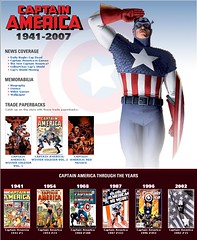 After those impressive beginnings, I was completely stunned at how badly the Marvel wrapped up its Civil War run, with Cap seemingly surrendering on a revelation — that the war between heroes was hurting a lot of innocent people in its wake — so mundane it bordered on stupid. That said, when Cap was actually gunned down by an assassin in Captain America #25, I could see where the story was supposed to have gone (I still think, though, that his death should have occurred in the last issue of the Civil War story, not another tie-in edition, even Cap’s own book). Cap’s death has altered the Marvel Universe, with even Tony Stark (Iron Man) privately admitting that the Civil War wasn’t worth the death of one of Marvel’s greatest icons (in Civil War: The Confession, yet another Civil war spin-off). There has been a lot of press about Marvel killing off one its core characters, but I think these stories are best summed up by Damian Fowler writing in The Guardian‘s books blogs with these insightful thoughts on ‘Why Captain America had to die’:
After those impressive beginnings, I was completely stunned at how badly the Marvel wrapped up its Civil War run, with Cap seemingly surrendering on a revelation — that the war between heroes was hurting a lot of innocent people in its wake — so mundane it bordered on stupid. That said, when Cap was actually gunned down by an assassin in Captain America #25, I could see where the story was supposed to have gone (I still think, though, that his death should have occurred in the last issue of the Civil War story, not another tie-in edition, even Cap’s own book). Cap’s death has altered the Marvel Universe, with even Tony Stark (Iron Man) privately admitting that the Civil War wasn’t worth the death of one of Marvel’s greatest icons (in Civil War: The Confession, yet another Civil war spin-off). There has been a lot of press about Marvel killing off one its core characters, but I think these stories are best summed up by Damian Fowler writing in The Guardian‘s books blogs with these insightful thoughts on ‘Why Captain America had to die’:
Created by Marvel comics in 1941 to battle the Nazis, the massively-pumped “Cap” was first seen punching Hitler in the face. Nice work if you can get it. But last week the patriotic crusader was shot and killed by a sniper in the latest issue of the long-running comic book.
Over the years, Captain America’s storyline has always reflected American moods and attitudes. When he first showed up, he was a sentinel of liberty and the fight for right. He was a mirror of everything that America stood for during the second world war. He always fought relentlessly for values that the US held dear.
How times change. Now he’s very much dead, something that was confirmed by the president and publisher of Marvel Entertainment. The New York Times all but wrote an obituary for the man, albeit in the arts pages, dead at 66. But it’s a sign of the times.
His demise is so much more than a tragedy in Toontown, even as the comic-book geeks mourn his passing. […] Cap’s death is being seen, analysed and discussed through the prism of national politics as a damning indictment of George Bush’s America. Even the major American TV networks picked up on the story, cutting images of the war in Iraq with the comic book images.
The Marvel Universe post-Captain America is an unfamiliar place. It’s a Marvel Universe in tune with the US and the Western world more broadly; a West which invaded Iraq four years ago but has to bring any semblance of stability to the region. With Cap’s shield gathering dust, his ideological opposite, Iron Man (a weapons manufacturer and alcoholic as well as a superhero) is now in charge of Marvel’s registered super-hero fighting machine (with a team in every state of the US). Spider-man, who revealed his identity during the Civil War, is now part of a small but notable underground resistance, but is also desperately trying to deal with the death of family members. Captain America’s death hangs over the comic book world, and leaves lasting questions about the direction and politics of the world of Marvel and its heroes.
However, As Benari Poulten reminds us, Captain America has been dead before and Steve Rogers has been replaced as Cap in the past, so it’s unlikely that the iconic hero will be gone from the Marvel universe for good. That said, Marvel have enjoyed amazing press and attention in the wake of the assassination of one of their key heroes — Cap’s demise even made ‘the Word’ on The Colbert Report and Steven Colbert now has Cap’s shield in his trophy case — so if death is to carry any weight at all in mainstream comic books, the inevitable return will have to be handled carefully, not just commercially. Personally, I think Steve Rogers should stay dead now, I think his death was representative of many things, including changes in Marvel both as a comic book universe and as part of a multi-national company. That said, words by Peter David about the X-Men titles are increasingly true about all comic book characters: “Mutant heaven has no pearly gates, only revolving doors” (X-Factor #70). If he can’t stay dead, Marvel, please earn any return of Captain America or one of your most striking characters will be diluted beyond a meaningful existence.
(Yes, the title of this post is a shameless adaptation of the Cap cartoon theme song; it’s also an homage to Henry Jenkins’ brilliant essay ‘Captain America Sheds His Might Tears: Comics and September 11’ which appeared in Daniel J. Sherman and Terry Nardin (eds), Terror, Culture, Politics: Rethinking 9/11, Indiana UP, 2006.)
